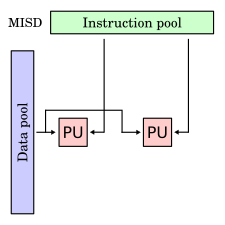
Back تعليمات متعددة بيانات وحيدة Arabic MISD Catalan Flynnsche Klassifikation#MISD (Multiple Instruction, Single Data) German MISD Spanish چند دستور یک داده Persian MISD Finnish Multiple instructions single data French MISD Italian MISD Japanese MISD Korean
This article is written like a personal reflection, personal essay, or argumentative essay that states a Wikipedia editor's personal feelings or presents an original argument about a topic. (April 2017) |

| Flynn's taxonomy |
|---|
| Single data stream |
| Multiple data streams |
| SIMD subcategories[1] |
| See also |
In computing, multiple instruction, single data (MISD) is a type of parallel computing architecture where many functional units perform different operations on the same data. Pipeline architectures belong to this type, though a purist might say that the data is different after processing by each stage in the pipeline. Fault tolerance executing the same instructions redundantly in order to detect and mask errors, in a manner known as task replication, may be considered to belong to this type. Applications for this architecture are much less common than MIMD and SIMD, as the latter two are often more appropriate for common data parallel techniques. Specifically, they allow better scaling and use of computational resources. However, one prominent example of MISD in computing are the Space Shuttle flight control computers.[2]
- ^ Flynn, Michael J. (September 1972). "Some Computer Organizations and Their Effectiveness" (PDF). IEEE Transactions on Computers. C-21 (9): 948–960. doi:10.1109/TC.1972.5009071.
- ^ Spector, A.; Gifford, D. (September 1984). "The space shuttle primary computer system". Communications of the ACM. 27 (9): 872–900. doi:10.1145/358234.358246. S2CID 39724471.